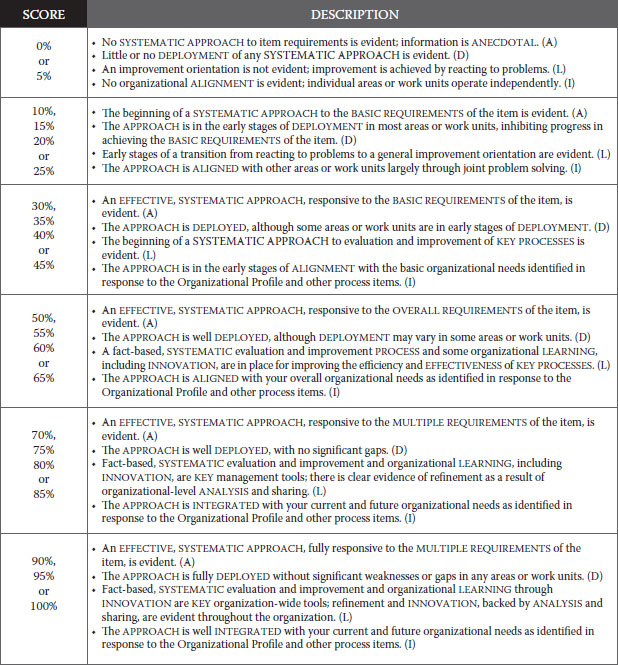
Business Excellence Assessment
Time has now come to carry out the self-assessment of the organization’s readiness to qualify for the Business Excellence Award. The goal is to deploy the Baldrige criteria as a business model to all of the organization’s facilities as a means to drive performance excellence.
The assessment will be based on the LATEST criteria of the BE Model based on Malcolm Baldrige National Quality Award (MBNQA). It is freely available at http://www.nist.gov/baldrige.
Category |
Points |
1. Leadership |
120 |
2. Strategic Planning |
85 |
3. Customer and Market Focus |
85 |
4. Information and Analysis |
90 |
5. HR Focus |
85 |
6. Process Management |
85 |
7. Business Results |
450 |
Total |
1000 |
ASSESSMENT SCORES FOR CATEGORIES 1 TO 7
Assessment scores are determined as per Baldrige criteria. Categories 1 to 6 are scored as per Figure 9.1.
Assessment score for Results Criteria 7 is scored as per Figure 9.2.
FIGURE 9.1
Scoring guidelines for use with Categories 1 to 6.
GUIDELINES FOR A WELL-WRITTEN COMMENT
A well-written comment addresses the following two guidelines: guidelines for content and guidelines for style, as shown in Figure 9.3.
The scoring of responses to criteria items and award applicant feedback are based on two evaluation dimensions: (1) process and (2) results. Criteria users need to furnish information relating to these dimensions. Specific factors for these dimensions are described below. Scoring guidelines are given in MBNQA Assessment Guidelines.
FIGURE 9.2
Scoring guidelines for use with Category 7.
“Process” refers to the methods your organization uses and improves to address the item requirements in Categories 1–6. The four factors used to evaluate process are Approach, Deployment, Learning, and Integration (A–D–L–I).
FIGURE 9.3
Postassessment guidelines for a well-written comment.
• The methods used to accomplish the process
• The appropriateness of the methods to the item requirements
• The effectiveness of use of the methods
• The degree to which the approach is repeatable and based on reliable data and information (i.e., systematic)
“Deployment” (D) Refers to the Extent to Which
• Your approach is applied in addressing item requirements relevant and important to your organization
• Your approach is applied consistently
• Your approach is used by all appropriate work units
• Refining your approach through cycles of evaluation and improvement
• Encouraging breakthrough change to your approach through innovation
• Sharing of refinements and innovation with other relevant work units and processes in your organization
“Integration” (I) Refers to the Extent to Which
• Your approach is aligned with your organizational needs identified in other criteria item requirements
• Your measures, information, and improvement systems are complementary across processes and work units
• Your plans, processes, results, analysis, learning, and actions are harmonized
“Results” refers to your organization’s outputs and outcomes in achieving the requirements in Chapter 8. The factors used to evaluate results are as follows:
• Your current level of performance
• Rate (i.e., slope of trend data) and breadth (i.e., how widely deployed and shared) of your performance improvements
• Your performance relative to appropriate comparisons and benchmarks
• Linkage of your results measures (often through segmentation) to important customer, product and service, market, process, and action plan performance requirements identified in your organizational profile and in process items
• The absence of a result that is required to be reported in a particular item is absent
The Certification Plan for all units of the organization
• Every applicable business unit is required to be certified.
• Any business unit that is certified and earns a score of 500 points or more will be reassessed in three years. Those certified with scores of less than 500 points will be reassessed in two years.
• The schedule for all plant assessments will be set according to the schedule for their business regardless of their score.
• All newly acquired facilities must have a BE baseline assessment completed 12 months after closing.
Continual improvement in the scores required translates into progress in the organizational performance. Table 9.1 suggests a plan for the first three years for a typical plant to achieve a score of 500 points.
Suggested Three Year Scoring Plan for BE Certification Process
Plant Certification—BEA Scores Required |
|||
Certification Cycle |
Overall Scores |
Category Scores |
Effective Date |
First assessment |
400 |
40% |
3/11 |
Second assessment |
450 |
40% |
6/12 |
Third assessment |
500 |
40% |
6/13 |
FIGURE 9.4
Circular chart: Business Excellence System Framework.
CIRCULAR CHART FOR EXCELLENT BUSINESS SYSTEM FRAMEWORK
The assessment touches each and every field described in the following circular chart for Excellent Business System Framework.
The circular chart shown in Figure 9.4 is an excellent guide summarizing the entire Business Excellence System Framework. In these four related books, I have endeavored to describe all elements in a simple and easy-to-understand manner. By following the book Business Excellence: Exceeding Your Customers’ Expectations Each Time, All the Time, it will be possible to attain a score of at least 400/1000 points in the first year, and as the years go by in the pursuit of excellence and proactively taking actions on all OFIs (opportunities for improvement) after each assessment, the organization can become one of the top admired businesses of the world.